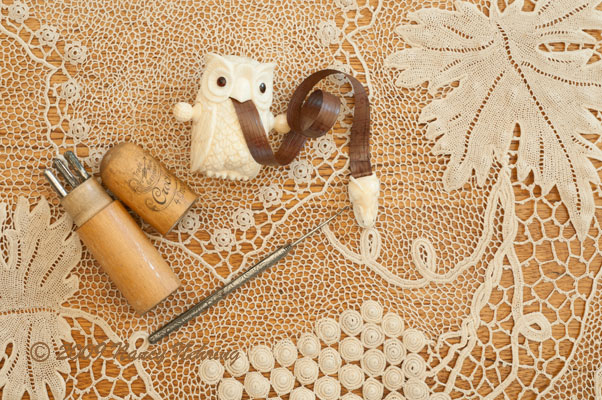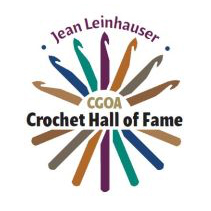This is an article I wrote which appears in my friend and fellow crocheter Margaret Hubert’s book
Hubert, Margaret, 2010, The Complete Photo Guide To Crochet, Creative Publishing International, Inc., Minneapolis, MN, p. 8-11.
Used with permission of the publisher.
Orvieto lace, crochet, cotton, maker unknown, Orvieto, Italy, circa 1900
Crochet: Developing a Craft
By Nancy Nehring
Modern crochet dates to the early 1800s and is well documented by Lis Paludan (1). She found no extant pieces that dated earlier than 1800 after an extensive search in the collections of European museums and churches. Likewise, she found no written references to needlework that can be positively identified as crochet existing before the same time period. A reference to shepherd’s knitting (slip stitch crochet) in The Memoirs of a Highland Lady by Elizabeth Grant dates to 1812. The earliest known instructions are in an article in Penelope magazine (Dutch) in 1824 discussing the new technique.
Crochet started out as only one stitch, the slip stitch (single crochet in British terminology). Slip stitch with wool was used in the colder northern climates from Scotland, through Scandinavia and on into eastern Europe turning south through Estonia all the way down into Bosnia. It was used to make warm, weatherproof clothing from wool. Mittens, underwear, and vests were most common. For mittens the wool was often fulled making them waterproof. It is still used today in a few places to make some of these same items. There wasn’t much incentive in these areas to produce items with decorative lacy stitches when warm clothing made from thick, solid fabrics was required.
At the same time slip stitch was used for personal accessories such as miser bags, purses and tobacco pouches in the warmer southern climates of France, the Netherlands and Germany. A solid fabric was needed so items would not fall out but warmth was not required. Early miser’s bags, purses and tobacco pouches were worked in multiple colors and either worked in rows or in the round in the back loop only. When working in rows, the work always had to be done from the right side so the yarn had to be broken at the end of each row. You can not turn the work in slip stitch because the pattern in the color work gets lost. Working in the round was borrowed from knitting and was done as a tube again working on the right side only. The open end was either gathered or folded in half and sewn.
Within 10 years of the earliest published miser bag patterns (1835) patterns for collars and baby and women’s caps were also being published in German and Dutch. The chain stitch and the single crochet stitch had been added to make these more decorative. This allowed more variety in shape and pattern, crochet was no longer limited to solid tubes and straight pieces. The chain stitch allowed chain meshes and corners to be made. Chain meshes are flexible and collar patterns without increases in the body became popular as the mesh would curve around the neck. But these collars were simple, consisting of mesh stitches for the body and chain “ladders” (of chain a few then single crochet in the single crochet below) for the edging. Caps were equally simple. Single crochet which had some height relative to slip stitch was used to make a flat circle for the crown by increasing the number of stitches each round (technique borrowed from knitting). Increases were not possible with slip stitch alone. For the brim, a rectangular section worked on the right side only with yarn broken at the end of each row, the same technique as slip stitch crochet except made with chains and single crochet stitches.
The next major innovation came another 10 years later when in 1846 and 1847 Mlle. Riego de la Branchardiere published patterns in England to reproduce raised Spanish needle lace. Not only was the lace three-dimensional but it was worked forwards and backwards, included taller stitches and was worked through both of the top loops. A complete foundation for crochet as we know it today was in place.
So how did we get from simple slip stitch to complex three-dimensional crocheted laces like Irish crochet in 30 years? Four factors were involved – material, tools, education of women, and travel – and all were the result of the Industrial Revolution.
Before the Industrial Revolution lacemaking was a professional skill done by individual workers, it was handmade. During the Industrial Revolution machines were invented that could make huge quantities of good quality lace fast. Commercial lacemaking was taken over by machines and, for the most part, handmade lace became a hobby. Crochet lace was the last to succumb (and in fact did not really get a good start until the same time period as the Industrial Revolution). It was the only lace that could not be duplicated by a machine and was fast to make relative to other types of lace. Elegant Irish crochet became the expensive handmade lace for the wealthy with dresses commanding prices in the range of $20,000 today.
It seems a human trait that once basic needs are met leisure time is used to create art and luxury. Upper class women had long pursued needlework as both a required skill and leisure activity. But the Industrial Revolution finally gave working middle class women some free time to use as they pleased, typically a half day on Saturday and all day Sunday if she had a job or a few minutes somewhere in the day if she was caring for a house and family. Crochet became a hobby of choice for upper and working class women having the advantages of stitches that were fast and easy to learn and of requiring only an inexpensive crochet hook and yarn/thread. Combining that with the desire to be fashion conscious, crochet took off.
Materials for crochet, a hooked needle and yarn/thread, weren’t always cheap. Before 1855 when the Bessemer process for large batch steel making was patented, consistently good quality needles were hard to make and expensive. The needle was made from wrought iron which was softer than steel so easier to work. Iron wire was cut to length, pointed and an eye punched in one end. For a crochet needle, one side of the eye was also removed by the punch. The iron needles were then packed into crucibles surrounded by charcoal, heated to white hot in pits in the ground and then cooled slowly using the insulating quality of the soil. Carbon from the charcoal infused into the iron making low grade steel. But the needles weren’t finished yet. A hard scale formed on the surface of the needles during heating and cooling and had to be polished off. Then the crochet needle was fitted into a handle for use.
By 1868 a single piece crochet hook (needle plus handle) was being made from tempered steel rod (US patent 76916) in a matter of a few hours from iron ore to finished hook. Hooks were now cheap and readily available.
Manufacture of yarn and thread underwent its own changes. Most bobbin and needle lace had been made with linen thread. Before the invention of the cotton gin about 1800 cotton thread was as expensive or more expensive that linen and not as strong because the fibers were shorter. In the first half of the 1800s England developed a huge textile industry based on spinning and weaving cotton so cotton thread became cheap, but it wasn’t very good for lace until mercerization was invented in 1844. Mercerization made cotton thread stronger, lustrous, and resistant to mold. It became more like linen.
Education of women, specifically teaching women to read, was critical in development of crochet. Professional crochet lacemakers were illiterate people who crocheted small, simple items from memory. French crocheted buttons and Irish crochet motifs were learned by watching another person. Then you specialized in that button or motif making hundreds of identical pieces. In Irish crochet, the various motifs were brought together and combined into a single accessory or garment by others who specialized in grounds.
But as a hobbyist the crocheter needed to be able to complete an entire accessory or garment herself. The product was more complex than a single motif and a written pattern became necessary. The crocheter needed to be able to read. Most upper class women had received at least basic education for nearly a century but it was the concentration of women in factories with free time afforded by the Industrial Revolution that created the opportunity for many working class women to obtain basic education. From 1850 to 1900 there were an increasing number of publications directed toward women: periodicals such as Godey’s Lady’s Book (1830) and Harper’s Bazaar (1867) and books such as DMC Guide to Needlework (1886).
Like today crocheters in the 1800s wanted a never-ending supply of new and different patterns. It wasn’t until the 1840s that crochet pattern books were first produced. One of the most influential crochet designers of this period was Mlle. Riego de la Branchardiere of London, England. She did much to popularize crochet by producing new designs and well written patterns beginning in 1846 that she sold as a series of inexpensive booklets (2). She was skilled in many types of needlework and taught “point, lacet, crochet, tatting, embroidery, lace-work, knitting, netting, tambour, etc.” Her crochet designs were innovative often borrowing ideas and design elements from other types of needlework. In her The Crochet Book, First Series, she is already experimenting with reproducing point laces (needle laces) in crochet. In her Second Series, she reproduces raised Spanish needle lace in crochet and claims that it is the origin of Irish crochet. Whether her claim of inventing Irish crochet is true or not (and it may be), her work is important because her books were widely used and popularized such innovations as turning the work, stitches taller than a single crochet, and raised (padded) work.
As crochet continued to gain in popularity, the demand for materials and patterns kept growing. Thread companies such as DMC, Coats, and Clark (Coats and Clark were separate companies at the time) viewed publishing patterns as great marketing tool to increase thread sales. One source of gridded patterns was existing pattern books for filet (darned net) and other types of needlework. The series Grand Album de Modeles (3) was heavily borrowed against.
In addition to using already published patterns, thread companies hired ladies to travel around Europe to study local needlework and then produce pattern books based on these needle works. Often the work was translated into crochet, being easy, fast, and already known to the target audience. In addition to the Spanish needle lace already mentioned, laces such as Cluny lace (bobbin lace), reticella (needle lace), Armenian lace (knotted lace), torchon lace (bobbin lace), princess lace (needle lace), and tatting (knotted lace) were imitated in crochet.
Travel worked in the other direction too. It distributed materials and patterns quickly around the world. The British Empire extended around the world and many British women craved a little of the luxury of back home in their lives. Crochet was an easy addition and these women further promoted crochet by teaching it to local women.
(1) Lis Paludan, Crochet History and Technique, 1995, Interweave Press, Inc., Loveland, CO.
(2) Mlle. Riego de la Branchardiere, The First Twelve Crochet Books of Mlle. Riego de la Branchardiere 1847-1852, 2007, Lacis Publications, Berkeley, CA.
(3) Boucherit, Edouard, editor, Nos. 1-10 Grand Album de Modeles pour Filet, circa 1880, Paris, France.
This version of the article is my original version without publisher’s editing.

